The museum has acquired two studies by French artist Isidore-Alexandre-Augustin Pils for his monumental painting The Reception of Kabyle Chiefs by Emperor Napoleon III and Empress Eugénie at Algiers on 18 September 1860 (1867, untraced). The following acquisitions join an oil sketch of the same subject that has been in the Dahesh collection since 2002.
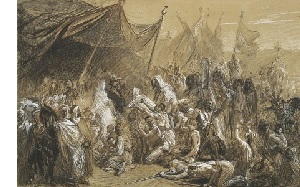
The Reception of Emperor Napoleon III and Empress Eugénie at Algiers on 18 September 1860
Black, brown and white chalk, stumping, brown wash, heightened with white on beige paper, 24 ¾ x 38 in.
2020.1
This preparatory drawing depicts the French Emperor and Empress being greeted by the Kabyle leaders and the natives. The catalog of the 1867 Universal Exposition—where the final painting was exhibited—described the scene: “… After the fantasia [an equestrian display performed during festivals and celebrations] the games, the hunts, everyone majestically approached the imperial tent where his Eminence stood. Then the chiefs, in their dazzling burnous [long cloak with hood], dismounted and came to offer the horse of Gaada, which was adorned with a gold cloth, as an act of submission to the sovereign of France …. The chief of the Kabyles, El-Hadj-Ahmed or Ali Iattaren of Taddart Oufella (the village at the top) of the Beni Raten, presented the rifle, surrounded by the Kabyle people who had scurried into the tent.”
Although Pils made numerous studies of the Kabyle people, he was unable to do the same for the Emperor and Empress. And so, the painting was not completed when it was exhibited in 1867, the Exposition catalog noting that the “figure of the Empress is not entirely finished.” Nevertheless, Pils received a first-class medal and the French government promoted him to Officer of the Legion of Honor.
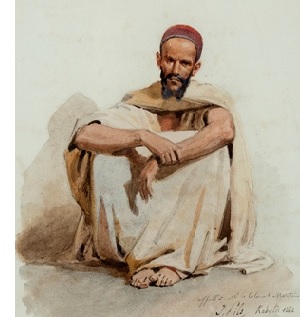
Study of Seated Kabyle, 1862
Watercolor on paper, 11 ¾ x 9 in.
Signed and dated lower right: I. Pils 1862
Inscribed lower right: offert à M le Colonel Martin
2019.1
After his immense success at the 1861 Paris Salon with Battle of Alma (Musée du Château de Versailles), Pils received a commission for a monumental painting to commemorate Emperor Napoleon III’s 1860 visit to the French colony of Algeria. This painting is now untraced, but the two painted sketches (at the Metropolitan Museum of Art and Musées et domaine nationaux du palais de Compiègne) and preparatory drawing (Dahesh Museum of Art) reveal that the sitter of this study is one of the Kabyle figures of the composition. Pils traveled to Algeria in 1861 and 1862 to study the landscape and people. After a sojourn in Algiers, whose character he felt had been influenced by the French occupation, Pils decided to go to the desert and mountains to find an “authentic Africa.” He went to the Kabyle region of northern Algeria—the Kabyles are a Berber people inhabiting the Atlas Mountains—where he stayed at Fort Napoleon. Pils made many studies (including preparatory drawings, watercolors, and oil sketches) for the final painting, a working method his academic training had instilled in him. However, the present watercolor identical to the Dahesh oil sketch, may have served a different function. While the sketch bears Pils’s signature, the watercolor contains an inscription indicating that the artist had offered it to Lieutenant Colonel Martin in 1862. According to the French army newspaper, Le Moniteur de l’Armée of 16 November 1862, Martin had just been reassigned from commander of Tizi-Ouzou (a town also in the Kabyle region) to commander of Fort Napoleon.
The Dahesh Museum of Art has acquired three American paintings, generously donated by William and Abigail Gerdts. All three works were painted in Europe by painters who were either expatriates or long-term residents. But, from a distance, all three paintings were also intended for the American art market by artists who remained actively involved with the American art world. As such each work marks an Atlantic crossing, truly representative of both the universality of the academic tradition and its global reach. The gift includes:
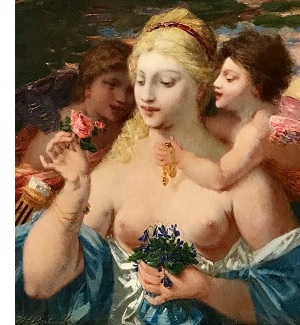
Diane et deux amours, 1860s–1870s
Oil on canvas, 11 3/8 x 9 3/4 in.
Signed lower left: Wm Babcock
Gift of William and Abigail Gerdts
2018.3
Babcock’s Classical paintings reflect the influence of the Barbizon master, Narcisse-Virgilio Diaz de la Peña (French, 1807/8–1876), who, in addition to his rural landscapes, painted rococo revival figure compositions throughout his career. Preparatory sketches for the painting are in the collection of the National Gallery of Art, Washington (Corcoran Collection).
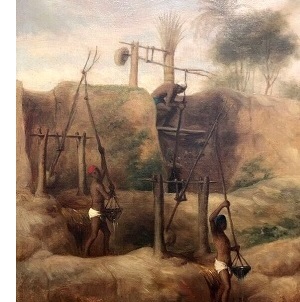
Water Carriers, Egypt, 1877
Oil on canvas, 12 1/8 x 9 in.
Gift of William and Abigail Gerdts
2018.2
While Hall is best-known for his finely detailed still lifes, he always considered himself primarily a figure painter. After exhibiting many French, Italian and Spanish scenes in New York, Hall traveled to the Middle East in the 1870s in search of Orientalist subject matter. Here, Hall’s fine attention to detail, interest in the figure, and nuanced sense of the exotic borders on reportage.
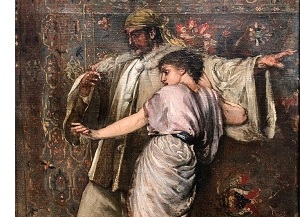
Study for “The Strayed Maskers,” ca. 1871
Oil on canvas, 10 3/8 x 12 1/2 in.
Signed lower right as a monogram: EB ROME
Gift of William and Abigail Gerdts
2018.1
When it was exhibited in Rome in 1872, the correspondent for the Boston Daily Advertiser described The Strayed Maskers:
“One of the noted American pictures of the season is by Eugene Benson. It also enjoys international repute, and is admired greatly by the artists of all nations…. It is a marvelously fine picture.”
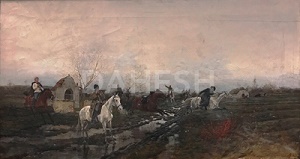
Scene of the January Uprising of 1863, 1882
Oil on canvas, 21 1/2 x 41 in.
Signed lower left: A. Piotrowski. 1882. Krakow.
2017.1
Antoni Piotrowski was a Realist painter and war correspondent, whose battle illustrations frequently appeared in French and British publications. After training in Wojciech Gerson’s studio and at the Academy of Fine Arts in Munich, he studied under Poland’s preeminent history painter Jan Matejko. He painted genre scenes and mythological vignettes, but his primary subject matter was battle imagery, and in 1885 he traveled to the Balkans to portray the Serbo-Bulgarian war. His cycle of nine paintings depicting this conflict toured Europe and won him the position of Court Painter to the Duke of Bulgaria as well as the prestigious Austrian Order of Litteris et Artibus. The present work depicts the recurrent motif of the Polish uprising against the Russian Empire in 1863: a group of Polish insurgents chase down an enemy soldier, who looks back in terror at a rebel preparing to fire on him.
Mrs. Mervat Zahid, President of the Dahesh Museum Board of Trustees, purchased this work from the van Eyck family estate, in memory of Mrs. Irene van Eyck—beloved mother of Museum board member Mr. Peter van Eyck. It is the second work by Piotrowski to enter the collection.
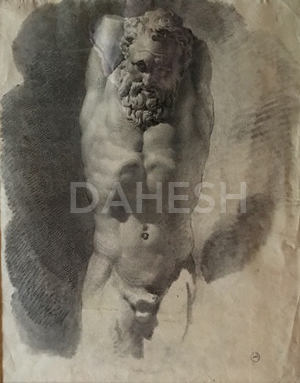
Study after an Antique Sculpture of Marsyas (Studio tratto da un’antica scultura di Marsyas), ca. 1810–20
Charcoal and white chalk on wove paper, 18 3/4 x 15 in.
Gift of Gina Milano in honor of Frank, Lucille, and Robert Milano
2016.6
The Dahesh recently acquired 11 drawings and a sketch album containing an additional 42 drawings by the Italian artist Tommaso Minardi, the generous gift of Gina Milano in honor of Frank, Lucille, and Robert Milano.
Minardi was a celebrated draftsman, who influenced generations of artists through his publications on aesthetics and as director of the Accademia di Belle Arti in Perugia (1819–1822) and professor at the Accademia di San Luca in Rome (1822–1852). The drawings and sketch album comprise exquisite examples of figure and facial studies as well as copies after Classical and Renaissance works, demonstrating Minardi’s divergent interests in Neoclassicism and Purismo––the Italian movement he championed that drew inspiration from the Nazarenes, a contemporary group of German artists active in Rome. Many of his works are notable for their study of light effects, as illustrated in the drawing of an ancient sculpture of Marsyas, in which he recreates the raking light across a marble surface.


